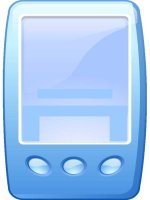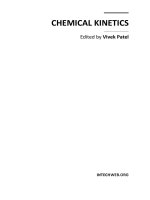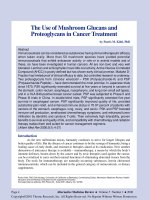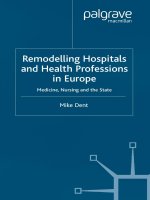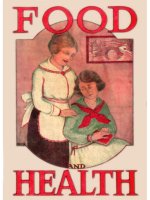Bronchoscopy and Esophagoscopy, by Chevalier Jackson potx
Bạn đang xem bản rút gọn của tài liệu. Xem và tải ngay bản đầy đủ của tài liệu tại đây (1.24 MB, 823 trang )
The Project Gutenberg eBook,
Bronchoscopy and Esophagoscopy, by
Chevalier Jackson
This eBook is for the use of anyone
anywhere at no cost and with almost no
restrictions whatsoever. You may copy
it, give it away or re-use it under the
terms of the Project Gutenberg License
included with this eBook or online at
www.gutenberg.org
Title: Bronchoscopy and Esophagoscopy
A Manual of Peroral Endoscopy and
Laryngeal Surgery
Author: Chevalier Jackson
Release Date: September 13, 2006
[eBook #19261]
Language: English
Character set encoding: ISO-646-US
(US-ASCII)
***START OF THE PROJECT
GUTENBERG EBOOK
BRONCHOSCOPY AND
ESOPHAGOSCOPY***
This book is one of the pioneering works
in laryngology. The original text is from
the library of Indiana University
Department of Otolaryngology-Head and
Neck Surgery, Bruce Matt, MD. It was
scanned, converted to text, and proofed
by Alex Tawadros.
BRONCHOSCOPY AND
ESOPHAGOSCOPY
A Manual of Peroral Endoscopy and
Laryngeal Surgery
by
CHEVALIER JACKSON, M.D.,
F.A.C.S.
Professor of Laryngology, Jefferson
Medical College, Philadelphia;
Professor of Bronchoscopy and
Esophagoscopy, Graduate School of
Medicine, University of Pennsylvania;
Member of the American
Laryngological Association; Member of
the Laryngological,
Rhinological, and Otological Society;
Member of the American Academy
of Ophthalmology and Oto-Laryngology;
Member of the American
Bronchoscopic Society; Member of the
American Philosophical Society;
etc., etc.
With 114 Illustrations and Four Color
Plates
Philadelphia And London
W. B. Saunders Company
1922
Copyrights 1922, by W. B. Saunders
Company
Made in U.S.A.
TO MY MOTHER
TO WHOSE
INTEREST IN
MEDICAL SCIENCE
THE AUTHOR
OWES HIS
INCENTIVE, AND
TO MY FATHER
WHOSE CONSTANT
ADVICE TO
"EDUCATE THE
EYE AND THE
FINGERS"
SPURRED THE
AUTHOR TO
CONTINUAL
EFFORT, THIS
BOOK IS
AFFECTIONATELY
DEDICATED.
PREFACE
This book is based on an abstract of the
author's larger work, Peroral Endoscopy
and Laryngeal Surgery. The abstract was
prepared under the author's direction by
a reader, in order to get a reader's point
of view on the presentation of the
subject in the earlier book. With this
abstract as a starting point, the author
has endeavored, so far as lay within his
limited abilities, to accomplish the
difficult task of presenting by written
word the various purely manual
endoscopic procedures. The large
number of corrections and revisions
found necessary has confirmed the
wisdom of the plan of getting the
reader's point of view; and these
revisions, together with numerous
additions, have brought the treatment of
the subject up to date so far as is
possible within the limits of a working
manual. Acknowledgment is due the
personnel of the W. B. Saunders
Company for kindly help.
CHEVALIER JACKSON. OCTOBER, 1922.
II
CONTENTS PAGE
CHAPTER I INSTRUMENTARIUM 17
CHAPTER II ANATOMY OF LARYNX,
TRACHEA, BRONCHI AND ESOPHAGUS,
ENDOSCOPICALLY CONSIDERED 52
CHAPTER III PREPARATION OF THE
PATIENT FOR PERORAL ENDOSCOPY
63 CHAPTER IV ANESTHESIA FOR
PERORAL ENDOSCOPY 65 CHAPTER V
BRONCHOSCOPIC OXYGEN
INSUFFLATION 71 CHAPTER VI
POSITION OF THE PATIENT FOR
PERORAl ENDOSCOPY 73 CHAPTER VII
DIRECT LARYNGOSCOPY 82 CHAPTER
VIII DIRECT LARYNGOSCOPY
(Continued) 91 CHAPTER IX
INTRODUCTION OF THE
BRONCHOSCOPE 97 CHAPTER X
INTRODUCTION OF THE
ESOPHAGOSCOPE 106 CHAPTER XI
ACQUIRING SKILL 117 CHAPTER XII
FOREIGN BODIES IN THE AIR AND
FOOD PASSAGES 126 CHAPTER XIII
FOREIGN BODIES IN THE LARYNX AND
TRACHEOBRONCHIAL TREE 149
CHAPTER XIV REMOVAL OF FOREIGN
BODIES FROM THE LARYNX 156
CHAPTER XV MECHANICAL
PROBLEMS OF BRONCHOSCOPIC
FOREIGN BODY EXTRACTION 158
CHAPTER XVI FOREIGN BODIES IN THE
BRONCHI FOR PROLONGED PERIODS
177 CHAPTER XVII UNSUCCESSFUL
BRONCHOSCOPY FOR FOREIGN
BODIES 181 CHAPTER XVIII FOREIGN
BODIES IN THE ESOPHAGUS 183
CHAPTER XIX ESOPHAGOSCOPY FOR
FOREIGN BODY 187 CHAPTER XX
PLEUROSCOPY 199 CHAPTER XXI
BENIGN GROWTHS IN THE LARYNX 201
CHAPTER XXII BENIGN GROWTHS IN
THE LARYNX (Continued) 203 CHAPTER
XXIII BENIGN GROWTHS PRIMARY IN
THE TRACHEOBRONCHIAL TREE 207
CHAPTER XXIV BENIGN NEOPLASMS
OF THE ESOPHAGUS 209 CHAPTER XXV
ENDOSCOPY IN MALIGNANT DISEASE
OF THE LARYNX 210 CHAPTER XXVI
BRONCHOSCOPY IN MALIGNANT
GROWTHS OF THE TRACHEA 214
CHAPTER XXVII MALIGNANT DISEASE
OF THE ESOPHAGUS 216 CHAPTER
XXVIII DIRECT LARYNGOSCOPY IN
DISEASES OF THE LARYNX 221
CHAPTER XXIX BRONCHOSCOPY IN
DISEASES OF THE TRACHEA AND
BRONCHI 224 CHAPTER XXX DISEASES
OF THE ESOPHAGUS 235 CHAPTER
XXXI DISEASES OF THE ESOPHAGUS
(Continued) 245 CHAPTER XXXII
DISEASES OF THE ESOPHAGUS
(Continued) 251 CHAPTER XXXIII
DISEASES OF THE ESOPHAGUS
(Continued) 260 CHAPTER XXXIV
DISEASES OF THE ESOPHAGUS
(Continued) 268 CHAPTER XXXV
GASTROSCOPY 273 CHAPTER XXXVI
ACUTE STENOSIS OF THE LARYNX 277
CHAPTER XXXVII TRACHEOTOMY 279
CHAPTER XXXVIII CHRONIC STENOSIS
OF THE LARYNX AND TRACHEA 300
CHAPTER XXXIX DECANNULATION
AFTER CURE OF LARYNGEAL
STENOSIS 309 BIBLIOGRAPHY 311
INDEX 315
[17] CHAPTER I—
INSTRUMENTARIUM
Direct laryngoscopy, bronchoscopy,
esophagoscopy and gastroscopy are
procedures in which the lower air and
food passages are inspected and treated
by the aid of electrically lighted tubes
which serve as specula to manipulate
obstructing tissues out of the way and to
bring others into the line of direct vision.
Illumination is supplied by a small
tungsten-filamented, electric, "cold"
lamp situated at the distal extremity of
the instrument in a special groove which
protects it from any possible injury
during the introduction of instruments
through the tube. The bronchi and the
esophagus will not allow dilatation
beyond their normal caliber; therefore, it
is necessary to have tubes of the sizes to
fit these passages at various
developmental ages. Rupture or even
over-distention of a bronchus or of the
thoracic esophagus is almost invariably
fatal. The armamentarium of the
endoscopist must be complete, for it is
rarely possible to substitute, or to
improvise makeshifts, while the
bronchoscope is in situ. Furthermore, the
instruments must be of the proper model
and well made; otherwise difficulties
and dangers will attend attempts to see
them.
Laryngoscopes.—The regular type of
laryngoscope shown in Fig. I (A, B, C)
is made in adult's, child's, and infant's
sizes. The instruments have a removable
slide on the top of the tubular portion of
the speculum to allow the removal of the
laryngoscope after the insertion of the
bronchoscope through it. The infant size
is made in two forms, one with, the other
without a removable slide; with either
form the larynx of an infant can be
exposed in but a few seconds and a
definite diagnosis made, without
anesthesia, general or local; a thing
possible by no other method. For
operative work on the larynx of adults,
such as the removal of benign growths,
particularly when these are situated in
the anterior portion of the larynx, a
special tubular laryngoscope having a
heart-shaped lumen and a beveled tip is
used. With this instrument the anterior
commissure is readily exposed, and
because of this it is named the anterior
commissure laryngoscope (Fig. 1, D).
The tip of the anterior commissure
laryngoscope can be used to expose
either ventricle of the larynx by lifting
the ventricular band, or it may be passed
through the adult glottis for work in the
subglottic region. This instrument may
also be used as an esophageal speculum
and as a pleuroscope. A side-slide
laryngoscope, used with or without the
slide, is occasionally useful.
Bronchoscopes.—The regular
bronchoscope is a hollow brass tube
slanted at its distal end, and having a
handle at its proximal or ocular
extremity. An auxiliary canal on its
under surface contains the light carrier,
the electric bulb of which is situated in a
recess in the beveled distal end of the
tube. Numerous perforations in the distal
part of the tube allow air to enter from
other bronchi when the tube-mouth is
inserted into one whose aerating function
may be impaired. The accessory tube on
the upper surface of the bronchoscope
ends within the lumen of the
bronchoscope, and is used for the
insufflation of oxygen or anesthetics,
(Fig. 2, A, B, C, D).
For certain work such as drainage of
pulmonary abscesses, the lavage
treatment of bronchiectasis and for
foreign-body or other cases with
abundant secretions, a drainage-
bronchoscope is useful The drainage
canal may be on top, or on the under
surface next to the light-carrier canal.
For ordinary work, however, secretion
in the bronchus is best removed by
sponge-pumping (Q.V.) which at the
same time cleans the lamp. The drainage
bronchoscope may be used in any case
in which the very slightly-greater area of
cross section is no disadvantage; but in
children the added bulk is usually
objectionable, and in cases of recent
foreign-body, secretions are not
troublesome.
As before mentioned, the lower air
passages will not tolerate dilatation;
therefore, it is necessary never to use
tubes larger than the size of the passages
to be examined. Four sizes are sufficient
for any possible case, from a newborn
infant to the largest adult. For infants
under one year, the proper tube is the 4
mm. by 30 cm.; the child's size, 5 mm. by
30 cm., is used for children aged from
one to five years. For children six years
or over, the 7 mm. by 40 cm.
bronchoscope (the adolescent size) can
be used unless the smaller bronchi are to
be explored. The adult bronchoscope
measures 9 mm. by 40 cm.
The author occasionally uses special
sizes, 5 mm. x 45 cm., 6 mm. x 35 cm., 8
mm. x 40 cm.
Esophagoscopes The esophagoscope,
like the bronchoscope, is a hollow brass
tube with beveled distal end containing a
small electric light. It differs from the
bronchoscope in that it has no
perforations, and has a drainage canal on
its upper surface, or next to the light-
carrier canal which opens within the
distal end of the tube. The exact size,
position, and shape of the drainage
outlets is important on bronchoscopes,
and to an even greater degree on
esophagoscopes. If the proximal edge of
the drainage outlet is too near the distal
end of the endoscopic tube, the mucosa
will be drawn into the outlet, not only
obstructing it, but, most important,
traumatizing the mucosa. If, for instance,
the esophagoscope were to be pushed
upon with a fold thus anchored in the
distal end, the esophageal wall could
easily be torn. To admit the largest sizes
of esophagoscopic bougies (Fig. 40),
special esophagoscopes (Fig. 5) are
made with both light canal and drainage
canal outside the lumen of the tube,
leaving the full area of luminal cross-
section unencroached upon. They can, of
course, be used for all purposes, but the
slightly greater circumference is at times
a disadvantage. The esophageal and
stomach secretions are much thinner than
bronchial secretions, and, if free from
food, are readily aspirated through a
comparatively small canal. If the canal
becomes obstructed during
esophagoscopy, the positive pressure
tube of the aspirator is used to blow out
the obstruction. Two sizes of
esophagoscopes are all that are required
—7 mm. X 45 cm. for children, and 10
mm. X 53 cm. for adults (Fig. 3, A and
B); but various other sizes and lengths
are used by the author for special
purposes.* Large esophagoscopes cause
dangerous dyspnea in children. If, it is
desired to balloon the esophagus with
air, the window plug shown in Fig. 6, is
inserted into the proximal end of the
esophagoscope, and air insufflated by
means of the hand aspirator or with a
hand bulb. The window can be replaced
by a rubber diaphragm with a
perforation for forceps if desired. It will
be noted that none of the endoscopic
tubes are fitted with mandrins. They are
to be introduced under the direct
guidance of the eye only. Mandrins are
obtainable, but their use is objectionable
for a number of reasons, chief of which
is the danger of overriding a foreign
body or a lesion, or of perforating a
lesion, or even the normal esophageal
wall. The slanted end on the
esophagoscope obviates the necessity of
a mandrin for introduction. The longer
the slant, with consequent acuting of the
angle, the more the introduction is
facilitated; but too acute an angle
increases the risk of perforating the
esophageal wall, and necessitates the
utmost caution. In some foreign-body
cases an acute angle giving a long slant
